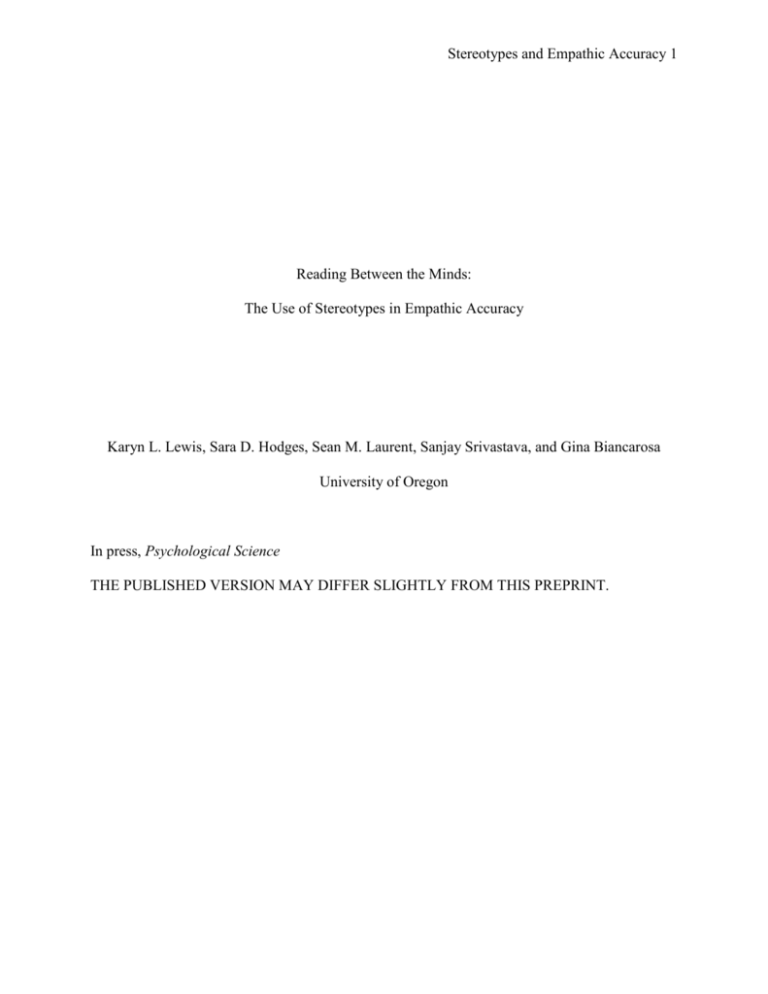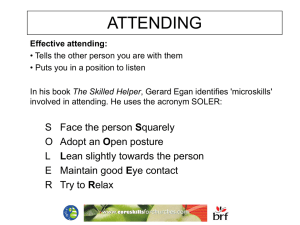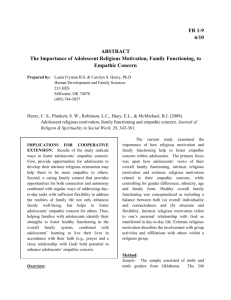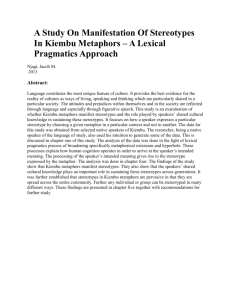hodges_inpress - Villanova University
advertisement

Stereotypes and Empathic Accuracy 1 Reading Between the Minds: The Use of Stereotypes in Empathic Accuracy Karyn L. Lewis, Sara D. Hodges, Sean M. Laurent, Sanjay Srivastava, and Gina Biancarosa University of Oregon In press, Psychological Science THE PUBLISHED VERSION MAY DIFFER SLIGHTLY FROM THIS PREPRINT. Stereotypes and Empathic Accuracy 2 Abstract An “ideal empathizer” may attend to another person’s behavior in order to understand that person, but it is also possible that empathically accurate perceivers use top-down strategies to understand others. We hypothesized that perceivers draw on stereotypes to infer others’ thoughts, and that stereotype use increases accuracy. Perceivers (N = 161) inferred the thoughts of multiple targets. Inferences consistent with stereotypes for the targets’ group (new mothers) were more accurate, particularly when actual thought content was also stereotypic, suggesting that drawing upon valid stereotypes helps perceivers more accurately understand others’ thoughts. The study’s secondary goal was to decompose empathic accuracy variance into thought, target, and perceiver variance. Although past research frequently focused on variance between perceivers or targets (which assumes individual differences in ability to understand others or be understood, respectively), the current study found the most substantial variance was within targets due to differences among thoughts. Stereotypes and Empathic Accuracy 3 Reading Between the Minds: The Use of Stereotypes in Empathic Accuracy It is difficult to think of a more fundamental social skill than accurately understanding other people, but after two decades of research on empathic accuracy – “everyday mind-reading” (Ickes, 2001) – researchers have been challenged to pin down variables that reliably predict this skill. The search for a “good judge” has turned up very few individual differences that are consistently predictive of empathic accuracy (for a review see Davis & Kraus, 1997). Several initially promising variables have turned out to be at best mediocre predictors of empathic accuracy, including self-reported empathy and perspective-taking (Myers & Hodges, 2009) and gender-related variables (Hodges, Laurent, & Lewis, 2011). We propose that one reason researchers have come up empty-handed may be that the search for predictors of empathic accuracy has been too narrow in its aim. Although many theorists acknowledge the role of top-down processing in empathy (e.g., Decety & Lamm, 2006), the candidate predictors that have typically been assessed (e.g., empathy, communion, motivation) reflect an idealized version of the accurate empathizer as someone who employs bottom-up strategies such as paying close attention to the specific words, nonverbal cues, and overt behaviors of a target person and then uses that information to deduce the person’s thoughts. In contrast, we propose that a substantial source of accuracy in inferring another’s thoughts comes from within the perceiver’s own mind. Contrary to the idealized view described above, we propose that perceivers may effectively use prior knowledge to “go beyond the information given.” One important source of knowledge may be characteristics associated with the target person’s roles or group memberships – that is, stereotypes. Of course, not all stereotypes contain Stereotypes and Empathic Accuracy 4 valid information (Hamilton & Gifford, 1976), but in instances where perceivers hold stereotypes that reflect real group characteristics, stereotypes may increase accuracy. We know of no previous research specifically examining the use of stereotypes in empathic accuracy, but related research and theories of interpersonal perception inform our hypothesis. In his PERSON model, Kenny (2004) proposes six sources of variance that influence interpersonal perceptions, and one of them is stereotypes. A key prediction of the PERSON model is that stereotypes contribute less variance to interpersonal perception when perceivers have access to more individuating information about the target, as typically happens when perceivers and targets become better acquainted. In studying sources of accuracy in personality trait judgments, Biesanz, West, and Millevoi (2007) found support for this prediction: As length of acquaintance increased, stereotype accuracy (i.e., accuracy at judging the generalized other) decreased and differential accuracy (i.e., accuracy at judging a specific target after removing stereotype accuracy and sources of bias) increased. Stated differently, when perceivers were less acquainted with a target and presumably had less individuating information upon which to inform their judgments, those judgments were based more on knowledge of a generalized (i.e., stereotypical) other. While Biesanz et al.’s work supports predictions from the PERSON model in the domain of personality trait judgments, in the present study, we propose that the same predictions can be made for empathic accuracy, another domain of interpersonal perception. Although the role of stereotypes in empathic inferences has not yet been examined, several previous studies demonstrate how perceivers use other kinds of top-down social knowledge to improve empathic accuracy. For instance, Stinson and Ickes (1992) found that male friends had higher accuracy for each other’s thoughts than did strangers. This effect was not due to dispositional similarity or a more highly involved interaction between target and Stereotypes and Empathic Accuracy 5 perceiver. Instead, the authors linked this effect to a level of understanding among friends that went beyond the immediate context of the interaction and drew upon stored knowledge from previous interactions. Similarly, Thomas and Fletcher (2003) found that empathic accuracy increases with intimacy, such that dating partners were more empathically accurate than friends, and friends more than strangers. The authors interpreted these findings to suggest that perceivers who were closer to a target had more extensive person-specific schemas to inform empathic inferences, whereas strangers had to rely more heavily on other sources of information. Taken together, these studies suggest that an existing relationship with a target benefits empathic accuracy because perceivers have already constructed person-specific schemas that contain a wealth of individualized information that can guide empathic inferences. However, the construction of person-specific schemas does not just occur among friends: Gesn and Ickes (1999) showed that schemas can develop quite rapidly if perceivers are given high-quality information about a target. In their study, perceivers watched a videotape of a target discussing a personal problem, and saw the tape either in its naturally occurring order or spliced in a random sequence. Perceivers in the natural-order condition showed more accuracy than those in the random-order condition, but only when the target’s thoughts were consistent with the ongoing dialogue of the interview. In other words, people who viewed the interview in the original order were able to construct a schema of the target to draw upon when making inferences about the target’s thoughts. When those thoughts were schema-consistent, accuracy was high; when the thoughts were schema-inconsistent, accuracy was low. Thus, perceivers seem to quickly start integrating information about targets into personalized schemas that can aid in making empathic inferences. Stereotypes and Empathic Accuracy 6 Thus, previous studies suggest that empathic accuracy increases with intimacy and acquaintanceship because a perceiver’s schema of a target becomes more extensive with accumulated knowledge from interactions and experiences with a person. However, people do not always have the luxury of acquaintance and yet often still manage to competently infer each other’s thoughts. We used Kenny’s PERSON model, which has previously been used in the domain of trait judgments but not empathic inferences, to derive our prediction about empathic accuracy with strangers. Specifically, we hypothesized that one reason perceivers can accurately understand strangers is because perceivers draw upon stereotypes. Although stereotypes generally evoke negative connotations as a source of bias in person perception that is related to prejudice (Brewer, 1996; Devine, 1989), stereotypes can also increase the accuracy of social perceptions (Jussim, Harber, Crawford, Cain, & Cohen, 2005). Thus, we hypothesized that perceivers draw upon stereotypes when inferring a target’s mental state, and as long as these stereotypes contain valid information, they may buy perceivers substantial accuracy in guessing a stranger’s thoughts. To gain a more nuanced view of how stereotypes might affect empathic accuracy, the current investigation used a novel multilevel design to analyze the stereotypicality of each distinct thought reported by the target person. Previous studies of empathic accuracy have aggregated thoughts within a target to circumvent violations of the assumption of independence required by traditional data-analytic techniques. However, one downside to collapsing accuracy across thoughts within a target is that it ignores potentially meaningful variations among individual thoughts within a target that may also be related to empathic accuracy. For example, a person might have some thoughts that are relatively stereotypical while having others that are Stereotypes and Empathic Accuracy 7 idiosyncratic. Examination of within-target, thought-to-thought variation has gone largely uninvestigated up to this point. Our multilevel design and analyses allowed us to simultaneously study thought-level variables, target-level variables, and perceiver-level variables. Moreover, multilevel modeling can be used to address another important question: What are the sources of variance in empathic accuracy? There might be individual differences among perceivers (people are good or bad at understanding others), individual differences among targets (some people are easy or difficult to understand), and variability among thoughts (some thoughts are easy or difficult to infer). Ickes, Buysse, et al. (2000) used a Social Relations Model (Kenny, 2004) to partition aggregated accuracy scores (averaged over thoughts) into perceiver variance, target variance, and residual variance, but they did not examine variance in individual thoughts. The current study builds upon past work by further partitioning variance of empathic accuracy into perceiver variance, target variance, and thought variance. In sum, understanding and describing what lies at the heart of empathic accuracy is an unfinished task and past research may have been limited due to theoretical focus and analysis choices. We considered a novel basis for empathic inferences (stereotypes) using a new methodological approach (multilevel design and analyses), which made it possible to ask two research questions: 1) Do perceivers draw upon group-based stereotypes to infer a target’s thoughts and does this improve empathic accuracy? and 2) How does thought-level variance compare to variance at the target and perceiver levels? In order to test our hypotheses, we designed a study in which each perceiver inferred multiple thoughts of multiple targets. We took advantage of naturally occurring group stereotypes by using targets who were all new mothers, a group about which many people hold stereotypes (Ganong & Coleman, 1995). We predicted Stereotypes and Empathic Accuracy 8 perceivers would show greater accuracy when their inferences were consistent with new mother stereotypes, particularly when new mothers’ thoughts were also consistent with stereotypes. Our predictions for the variance decomposition were tentative. Based on Ickes et al. (2000), we predicted nonzero perceiver and target variance, but suspected that target variance might be modest when thought variance is explicitly modeled and estimated. Method A total of 161 predominately Caucasian (78.9%) undergraduate students (93 women; M age = 19.80, SD = 3.10) participated in exchange for partial course credit in introductory psychology courses. Procedure Participants were run in small groups and were randomly assigned to one of six order conditions (described below). Each participant sat in an individual cubicle. All instructions and experimental materials were presented via computer using MediaLab presentation software (Jarvis, 2000). Participants’ empathic accuracy was assessed using the “standard stimulus” paradigm developed by Marangoni, Garcia, Ickes, and Teng (1995). In this task, each perceiver watches a videotape showing the naturalistic behavior of a target, and the perceiver attempts to infer the target’s thoughts. The 14 targets in the current study were women who had recently given birth to their first child and were interviewed about this experience (see Hodges, Kiel, Kramer, Veach, & Villanueva, 2010 for additional details). Immediately after the video was originally made, each target watched the video and reported any specific thoughts or feelings1 she remembered having had during the interview. When perceivers viewed the videos, the tapes were stopped at 1 Both are referred to as “thoughts” henceforward. Stereotypes and Empathic Accuracy 9 the specific moments that the target reported having had a thought, and perceivers were asked to infer what the target was thinking at that moment. To allow time for each participant to view multiple targets, only the first four thought “stops” for each target were shown. To control for order effects in the presentation of targets, a pseudo Latin-square design was used to devise six order conditions. Participants worked at their own pace and viewed as many targets as possible in the allotted time for the experimental session (mean number of targets viewed = 11.98, SD = 2.50). Measures Empathic accuracy scores. To assess empathic accuracy (following Ickes et al., 1990), six coders compared each participant’s inferences to the actual thoughts reported by the target. The responses were coded for accuracy using a 3-point scale (0 being essentially different content, 1 being somewhat similar, but not the same, content, and 2 being essentially the same content). The ratings for each inference were averaged across judges (Cronbach’s α = .85). The mean accuracy score was rescaled to yield a scale ranging from 0 (zero accuracy) to 100 (complete accuracy). Stereotypicality of targets’ thoughts. A different set of coders rated the stereotypicality of each thought reported by each of the targets (targets were divided into two sets with 14 coders rating the first set and 17 coders rating the second set). Coders rated “to what extent the thoughts… were characteristic of what a typical new mother would say about her experience” using a 4-point scale (1 = uncharacteristic, 2 = neither characteristic nor uncharacteristic, 3 = somewhat characteristic, 4 = very characteristic). For example, coders rated the thought “I was thinking how exhausting it is to have a newborn baby and how challenging it was to find time for myself” as highly characteristic (M = 3.71) and the thought “I was feeling sad—as if the pre-baby Stereotypes and Empathic Accuracy 10 me has been lost—I don’t know where ‘she’s’ gone” (M = 1.71) as less characteristic. Ratings were averaged across coders for each thought (Cronbach’s α first set of coders = .80, Cronbach’s α second set of coders = .87). Stereotypicality of perceivers’ inferences. A different set of coders rated the stereotypicality of each inference made by each perceiver. Coders rated “to what extent the inferences presented were characteristic of what a typical new mother would say about her experience” using the same 4-point scale as above. For example, coders rated the inference “I think she was thinking how her baby is her top priority now and she has less time for herself” as highly characteristic (M = 4.00) and the inference “I think she was feeling disappointed to have had a child” (M = 1.33) as less characteristic. Ratings were averaged across coders for each thought (Cronbach’s α = .68). Baseline accuracy scores. Also following Ickes et al. (1990), we estimated average baseline accuracy. Baseline accuracy refers to the overlap between the content of perceivers’ inferences and targets’ thoughts that is due to general knowledge of a target or of the whole target pool, rather than distinctive knowledge of one specific thought. Our multilevel design made it possible to assess baseline accuracy both within and across targets. To estimate withintarget baseline accuracy, we randomly selected a subsample of 20% of the perceivers (n = 32), and for each one we selected three random targets. For each target we then randomly selected two of the perceiver’s inferences and paired them with two other randomly selected thoughts reported by that target (these pairings were never duplicated and no original pairings were allowed). To estimate across-target baseline accuracy, we randomly selected (with replacement from the previous sample) another subsample of 20% of the perceivers (n = 32). For each perceiver, we randomly selected six targets they had viewed. We paired one randomly selected Stereotypes and Empathic Accuracy 11 inference that they had made for each target with another randomly selected thought reported by a different target. These pairings were rated for accuracy (using the same 3-point scale as above) by four judges. Accuracy ratings for each inference were averaged across judges separately for within-target baseline accuracy coding (Cronbach’s α = .81) and across-targets baseline accuracy coding (Cronbach’s α = .74). Transparency of thoughts. In order to ensure that any effect of stereotypicality was not simply the result of stereotypic thoughts being less difficult to infer, we also coded the transparency of each thought to use as a covariate in all analyses (see Marangoni et al., 1995). To code transparency, another pool of 35 coders (a different group than those who rated stereotypicality) watched the target videos, with each target’s videotape was shown to a subset of coders (M coders per target = 7.5). At each point in the video that the target reported a thought, these coders were shown the actual thought reported by the target and were asked to rate “How difficult would it be to infer this thought given what you’ve seen and heard in the video?” using a 3-point scale (1 = very difficult to infer, 2 = somewhat difficult to infer, 3 = easy to infer). Different coders saw different subsets of videos, so to index the dependability of these ratings, we used a multilevel model to partition the total variance in transparency into coder variance, target variance, thought variance, and residual variance, and then computed a ratio of thought variance to thought plus residual variance. This estimate (40.66%) indicated that relative to the residual variance, there was reliable variance in transparency across thoughts, thus transparency ratings were averaged across coders. Results All analyses were performed using SPSS Mixed (version 17). Given the structure of the data (thoughts nested in targets which were crossed with perceivers), a 2-level cross-classified Stereotypes and Empathic Accuracy 12 model was used. All models were tested using full maximum likelihood estimation and all predictor variables were grand mean centered. All models included random effects of the intercept for thoughts (µ0k) and perceivers (µ0i) and all other effects were treated as fixed given the small number of observations (i.e., thoughts) per target at level 1. Table 1 displays a summary of all parameter estimates. The model equation was as follows: Yijk = β0ik+ β1Transparencyjk + β2T_Stereojk + β3I_Stereoijk + β4I_ Stereoijk X T_Stereojk + εijk β0ik = γ00 + γ01Sexi + µ0i + µ0k Yijk is perceiver i’s empathic accuracy for thought k from target j. Transparencyjk is the transparency for target j’s thought k. T_Stereojk is the stereotypicality of target j’s thought k. I_Stereoijk is the stereotypicality of perceiver i’s inference for target j’s thought k. Null Model. A null model with no predictors was fitted to decompose the variance in empathic accuracy into that which was due to differences among perceivers, differences among targets, and differences among thoughts nested within targets. As seen in Table 1, of the total variance in empathic accuracy (σ2 = 733.81), the majority of the predictable variance was due to differences between thoughts within a target (19.03% at the thought level). The perceiver level variance was smaller, but significant (6.66% at the perceiver level). Variance at the target level was so close to zero that models including this effect would not converge. To confirm with a simpler analysis that there was no variance due to differences among targets, we computed the average accuracy of each target’s first, second, third, and fourth thought (averaging over perceivers), and then we computed the correlations (across targets) between the 4 thoughts. The average correlation was not significantly different from zero (r = -.08, p = .32) again suggesting that there is no variance in empathic accuracy attributable to systematic differences between targets. Stereotypes and Empathic Accuracy 13 Full Model.2 How accurate were perceivers overall? The grand mean (i.e., the intercept) for empathic accuracy was 24.22, t = 15.95, p < .001. Because empathic accuracy ranged from 0 to 100, one way to interpret this mean is that perceivers achieved about 25% of the maximum possible accuracy scores. This intercept can also be compared against the mean baseline accuracy measures, which are based on the accuracy scores of perceivers’ inferences paired with randomly mismatched thoughts. The mean within-target baseline accuracy was 20.34 (SD = 25.75) and the mean across-targets baseline accuracy was 16.54 (SD = 21.13). Although the mean within-target baseline accuracy was slightly higher, these means did not differ from one another (t(382) = 1.58, p = .11). This suggests that for this sample of perceivers, empathic accuracy was composed largely of stereotype accuracy and to a much lesser extent actual distinctive accuracy – knowing what a particular target was thinking at a specific time after correcting for guessing based on general knowledge of a particular target or of the target pool as a whole. We hypothesized that perceivers draw upon stereotypes to make empathic inferences, and that using stereotypes results in higher accuracy when the stereotypes contain valid information. Inference stereotypicality significantly predicted empathic accuracy (b = 7.27, t = 16.22, p < .001); more stereotypic inferences were more accurate. Thought stereotypicality also significantly predicted empathic accuracy (b = 5.79, t = 2.04, p = .05); more stereotypic thoughts were more accurately read. More importantly, as the critical test of our hypothesis, the interaction between inference stereotypicality and thought stereotypicality was also significant (b = 8.31, t = 10.93, p < .001). As hypothesized, overall perceivers were most accurate when their 2 Before adding any predictors, we tested for an order-of-target-presentation effect which was nonsignificant (p > .4). Stereotypes and Empathic Accuracy 14 inferences were more stereotypical of new mothers, but this was especially true when those new mothers’ thoughts were stereotypic (see Figure 1). The size and direction of these effects remained largely unchanged when thought transparency (scaled so that higher values indicated more transparent thoughts; b = 7.16, t = 2.49, p = .02) was added to the model, although the main effect of thought stereotypicality became nonsignificant (see Table 1 for the parameter estimates from the full model). Our theoretical focus was not on sex differences; however, in light of previous literature on possible sex differences in empathic accuracy (Hodges et al., 2011), as well as the gendered nature of the target stimuli (women discussing motherhood), we ran a model to explore for sex differences. Perceiver sex was a significant predictor of the intercept (b = -2.10, t = 4.03, p < .001): On average, men had lower accuracy than women. Discussion This study examined the role of stereotypes in empathic accuracy and provides novel insight into how perceivers accurately infer the thoughts of targets. In line with predictions, perceivers showed greater accuracy when they drew upon stereotypes, particularly when inferring stereotype-consistent thoughts, even after controlling for how transparent a particular thought was. Is relying on stereotypes a good strategy for mind reading? The answer to this question is yes … and also no. Our data suggest that relying on stereotypes can buy perceivers some accuracy that may otherwise be difficult to come by if the perceiver is unacquainted with that target. However, the gains in accuracy depended upon the targets’ thoughts being stereotypeconsistent. Extrapolating from the present findings, we would predict that empathic inaccuracy might result from relying on group-based stereotypes that are largely inaccurate; this would be a Stereotypes and Empathic Accuracy 15 promising avenue for future study. In addition to containing some accurate information, the stereotype of new mothers is mostly neutral or positive in valence (e.g., new mothers are stereotyped as tired but also happy). Future research on the use of a wider range of stereotypes, such as negative stereotypes and stereotypes that cover a wider range of content, will also be important. A second goal of the current study was to examine variation in empathic accuracy at different levels. Variance decomposition analyses revealed that there was little variance at the perceiver level (7%) and no variance at the target level, but there was more substantial variance within targets at the thought level (19%). Interpreting this finding in light of Funder’s (1995) realistic accuracy model, one implication of this result is that searching for characteristics of a good judge or a good target may be less fruitful than considering what characteristics make for good information (i.e., what makes a thought more or less readable). Given that several studies have searched and failed to identify the characteristics of a good judge of empathic accuracy (Davis & Kraus, 1997), this is an important direction for future researchers to explore. Previous attempts to understand empathic accuracy may have been hampered by methodological limitations which focused exclusively on between-perceiver or between- target variability. The present study was designed to also examine within-target variability, because for any given target, thoughts may vary in important ways. We found evidence that perceivers used group-based stereotypes to inform empathic inferences, which helped them to infer some (but not all) thoughts and feelings. Including stereotypes in the pool of strategies used for achieving empathic accuracy may run counter to idealized views of empathy, but we liken this process to reading “between the lines” in a story. A reader’s understanding of a text is affected not just by the words on the page, but also by prior knowledge and expectations that the reader brings to the Stereotypes and Empathic Accuracy 16 text. Similarly, when people try to read others’ minds, they look beyond what is directly observable and use prior knowledge, including stereotypes, to fill in some of the gaps. While relying on stereotypes may not be the key to achieving complete accuracy, this strategy may under certain circumstances make an otherwise closed book more accessible. Stereotypes and Empathic Accuracy 17 References Biesanz, J. C., West, S. G., & Millevoi, A. (2007). What do you learn about someone over time?: The relationship between length of acquaintance and consensus and self-other agreement in judgments of personality. Journal of Personality and Social Psychology, 92, 119-135. Brewer, M. B. (1996). When stereotypes lead to stereotyping: The use of stereotypes in person perception. In C. N. Macrae, C. Stangor, & M. Hewstone (Eds.), Stereotypes and stereotyping (pp. 254-275). New York, NY: Guilford Press. Davis, M. H., & Kraus, L. A. (1997). Personality and empathic accuracy. In W. Ickes (Ed.), Empathic accuracy (pp. 144-168). New York: Guilford. Decety, J., & Lamm, C. (2006). Human empathy through the lens of social neuroscience. The Scientific World Journal, 6, 1146–1163. Devine, P. G. (1989). Stereotypes and prejudice: Their automatic and controlled components. Journal of Personality and Social Psychology, 21, 281-295. Funder D. C. (1995). On the accuracy of personality judgment: A realistic approach. Psychological Review, 102, 652-670. Ganong, L., & Coleman, M. (1995). The content of mother stereotypes. Sex Roles, 32, 495-512. Gesn, P. R., & Ickes, W. (1999). The development of meaning contexts for empathic accuracy: Channel and sequence effects. Journal of Personality and Social Psychology, 77, 746761. Hamilton, D. L., & Gifford, R. K. (1976). Illusory correlation in interpersonal perception: A cognitive basis of stereotypic judgments. Journal of Experimental Social Psychology, 12, 392-407. Stereotypes and Empathic Accuracy 18 Hodges, S. D., Kiel, K. J., Kramer, A. D. I., Veach, D., & Villanueva, R. (2010). Giving birth to empathy: The effects of similar experience on empathic accuracy, empathic concern, and perceived empathy. Personality and Social Psychology Bulletin, 36, 398-409. Hodges, S. D., Laurent, S. M., & Lewis, K. L. (2011). Specially motivated, feminine, or just female: Do women have an empathic accuracy advantage? In J. Smith, W. Ickes, J. Hall, & S. Hodges, (Eds.), Managing interpersonal sensitivity: Knowing when -and when notto understand others (pp. 59-73). Hauppauge, NY: Nova Science Publishers. Ickes, W. (2001). Measuring empathic accuracy. In J. A. Hall, & F. J. Bernieri (Eds.), Interpersonal sensitivity: Theory and measurement (pp. 3-20). Mahwah, NJ, US: Lawrence Erlbaum Associates Publishers. Ickes, W., Buysse, A., Pham, H., Rivers, K., Erickson, J. R., Hancock, M., Kelleher, J., & Gesn, P. R. (2000). On the difficulty of distinguishing ‘good’ and ‘poor’ perceivers: A social relations analysis of empathic accuracy data. Personal Relationships, 7, 219-234. Jarvis, W. B. G. (2000). MediaLab [Computer software]. Columbus, OH: Empirisoft. Jussim, L., Harber, K. D., Crawford, J. T., Cain, T. R., & Cohen, F. (2005). Social reality makes the social mind: Self-fulfilling prophecy, stereotypes, bias, and accuracy. Interaction Studies, 6, 85-102. Kenny, D. A. (1988). Interpersonal perception: A social relations analysis. Journal of Social and Personal Relationships, 5, 247-261. Kenny, D. A. (2004). PERSON: A general model of interpersonal perception. Personality and Social Psychology Review, 8, 265-280. Marangoni, C., Garcia, S., Ickes, W., & Teng, G. (1995). Empathic accuracy in a clinically relevant setting. Journal of Personality and Social Psychology, 68, 854-869. Stereotypes and Empathic Accuracy 19 Myers, M. W., & Hodges, S. D. (2009). Making it up and making do: Simulation, imagination and empathic accuracy. In K. Markman, W. Klein, & J. Suhr (Eds.), The handbook of imagination and mental simulation (pp. 281-294). New York: Psychology Press. Stinson, L., & Ickes, W. (1992). Empathic accuracy in the interactions of male friends versus male strangers. Journal of Personality and Social Psychology, 62, 787-797. Thomas, G., & Fletcher, G. J. O. (2003). Mind-reading accuracy in intimate relationships: Assessing the roles of the relationship, the target, and the judge. Journal of Personality and Social Psychology, 85, 1079-1094. Stereotypes and Empathic Accuracy 20 Author Note Sean M. Laurent is now at the University of Wyoming. Acknowledgements: We thank Joseph Stevens for helpful comments on an early draft of this manuscript and Jeremy Biesanz for his insightful review. Correspondence concerning this article should be addressed to Karyn Lewis, University of Oregon, Department of Psychology, 1227 University of Oregon, Eugene, OR 97403. Email: klewis3@uoregon.edu. Stereotypes and Empathic Accuracy 21 Table 1 Summary of Variance Decomposition and Parameter Estimates Variance Decomposition Null Model Residual Thoughts Perceivers Full Model Residual Thoughts Perceivers Variance SE 𝜒2 p 546.11 139.61 48.86 9.01 27.39 6.87 Percent of Total 60.59 <.001 74.42% 5.10 <.001 19.03% 7.15 <.001 6.66% 523.30 113.78 30.68 8.64 22.84 4.77 60.58 <.001 4.98 <.001 6.43 <.001 Percent of Total 78.37% 17.04% 4.59% Percent Change 4.18% 18.50% 37.21% B SE t p Fixed Effects Intercept 24.22 1.52 15.95 < .001 Perceiver Sex -2.10 0.52 4.03 < .001 I_Stereo 7.28 0.45 16.28 < .001 T_Stereo 3.20 2.91 1.10 .28 I_Stereo X T_Stereo 8.26 0.76 10.88 < .001 Transparency 7.16 2.87 2.49 .02 *Note. For the full model, the last column displays the percent of variance explained at that level (relative to the null model) by the fixed effects. Stereotypes and Empathic Accuracy 22 Figure Caption Figure 1. The upper panels display scatterplots of empathic accuracy (aggregated across perceivers for each thought) plotted against thought stereotypicality (a) and thought transparency (b). Panel c displays a hexbin plot of empathic accuracy plotted against inference stereotypicality. Panel d displays predicted empathic accuracy as a function of the interactive effect of thought stereotypicality and inference stereotypicality (low = -1 SD and high = +1 SD). a d 40 35 Empathic Accuracy c b 30 Inference Stereotypicality 25 Low Mean 20 High 15 10 Low Mean High Thought Stereotypicality








